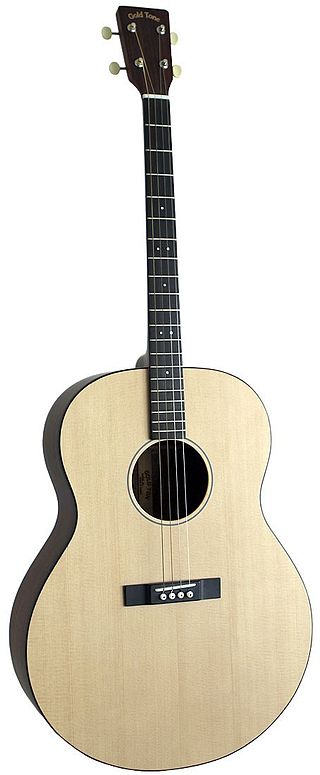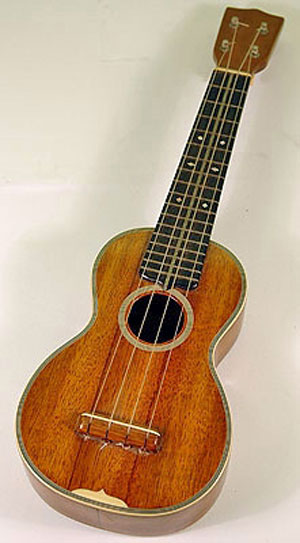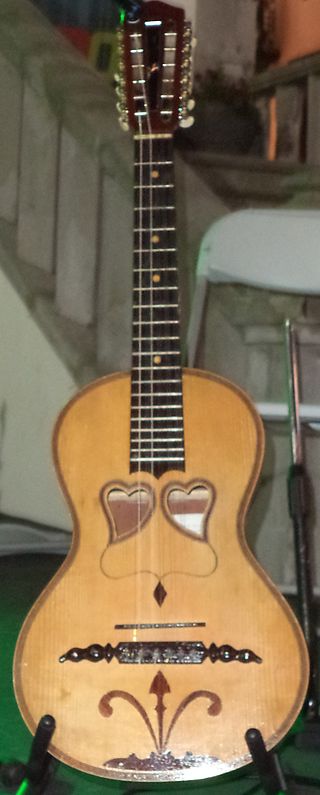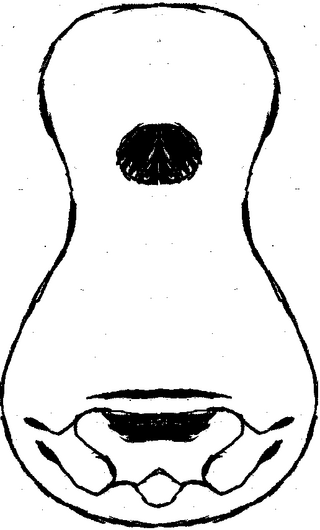
A mandolin is a stringed musical instrument in the lute family and is generally plucked with a pick. It most commonly has four courses of doubled strings tuned in unison, thus giving a total of eight strings. A variety of string types are used, with steel strings being the most common and usually the least expensive. The courses are typically tuned in an interval of perfect fifths, with the same tuning as a violin. Also, like the violin, it is the soprano member of a family that includes the mandola, octave mandolin, mandocello and mandobass.

The seven-string guitar adds one additional string to the more common six-string guitar, commonly used to extend the bass range or also to extend the treble range.

A tiple, is a plucked typically 12-string chordophone of the guitar family. A tiple player is called a tiplista. The first mention of the tiple comes from musicologist Pablo Minguet e Irol in 1752. Although many variations of the instrument exist, the tiple is mostly associated with Colombia, and is considered the national instrument. The Puerto Rican version characteristically has fewer strings, as do variants from Cuba, Mallorca, and elsewhere among countries of Hispanic origin.

The Russian guitar (sometimes referred to as a "Gypsy guitar") is an acoustic seven-string guitar that was developed in Russia toward the end of the 18th century: it shares most of its organological features with the Spanish guitar, although some historians insist on English guitar descent. It is known in Russian as the semistrunnaya gitara (семиструнная гитара), or affectionately as the semistrunka (семиструнка), which translates to "seven-stringer". These guitars are most commonly tuned to an open G chord as follows: D2 G2 B2 D3 G3 B3 D4. In classical literature, the lowest string (D) occasionally is tuned down to the C.

The tenor guitar or four-string guitar is a slightly smaller, four-string relative of the steel-string acoustic guitar or electric guitar. The instrument was initially developed in its acoustic form by Gibson and C.F. Martin so that players of the four-string tenor banjo could double on guitar.
In music, standard tuning refers to the typical tuning of a string instrument. This notion is contrary to that of scordatura, i.e. an alternate tuning designated to modify either the timbre or technical capabilities of the desired instrument.

A classical guitar with additional strings is a nylon-string or gut-string classical guitar with more than six strings, in which the additional strings pass over a fingerboard so that they may be "stopped" or fretted with the fingers. These are also known as extended-range guitars, and should not be confused with harp guitars.

The çifteli is a plucked string instrument, with only two strings, played mainly by the Albanians of northern and central Albania, southern Montenegro and parts of North Macedonia and Kosovo.

On a stringed instrument, a break in an otherwise ascending order of string pitches is known as a re-entry. A re-entrant tuning, therefore, is a tuning which does not order all the strings from the lowest pitch to the highest pitch.

The huapanguera, guitarra quinta huapanguera or guitarra huapanguera is a Mexican guitar-like instrument that usually forms part of a conjunto huasteco ensemble, along with the jarana huasteca and violin. Because of its large body and deeper structure, the huapanguera is able provide a much deeper sound compared to a regular acoustic guitar. Here it takes on the role of the bass instrument using a rhythmical strumming technique. Its physical construction features a large resonating body with a short neck. It normally has around 10 frets which stop at the point where the fingerboard meets the top.

Laúd is a plectrum-plucked chordophone from Spain, played also in diaspora countries such as Cuba and the Philippines.

The viola amarantina is a stringed musical instrument from Amarante, Northern Portugal. It is also named viola de dois corações because of the two heart-shaped frontal openings. It has 10 strings in 5 courses. The strings are made of steel. It is tuned A3 A3, F# F#, B2 B3, G2 G3, D2 D3.
The halszither is a stringed instrument from Switzerland. It has nine steel strings in five courses and is tuned: G2, D3 D3, G3 G3, B3 B3, D4 D4.
The guitarrón argentino is a stringed musical instrument from Argentina. It has 6 strings in 6 courses and is tuned B1, E2, A2, D3, G3, B3. The strings are made of nylon.

Viola da terra is a stringed musical instrument from the islands of the Azores, closely associated with the saudade genre of Portuguese music. Its 12 or 15 metal strings are arranged in either five or six courses.
The Viola de arame is a stringed musical instrument from the Portuguese island of Madeira. It has 9 strings in 5 courses. The strings are made of steel.
The viola da Terceira is a stringed musical instrument of the guitar family, from the Portuguese islands of the archipelago of the Azores, associated with the island of Terceira.

The viola toeira is a stringed musical instrument from Portugal. It has 12 strings in five courses. The strings are made of steel. It is tuned A3 A3 A2, D3 D3 D2, G3 G2, B3 B3, E3 E3.

The Algerian mandole is a steel-string fretted instrument resembling an elongated mandolin, widely used in Algerian music such as Chaabi, Kabyle music and Nuubaat.

The tambura is a stringed instrument that is played as a folk instrument in Bosnia and Herzegovina, Bulgaria, Croatia, Hungary, North Macedonia, Serbia and Turkey. It has doubled steel strings and is played with a plectrum, in the same manner as a mandolin.














